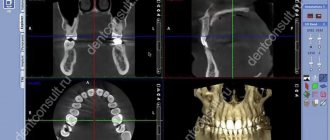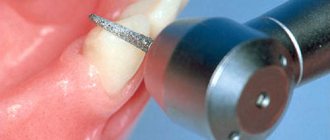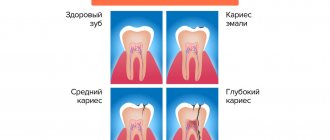- What is tartar
- How is tartar formed?
- Types of Tartar
- Symptoms and consequences of tartar
- How to prevent tartar formation
- Methods for removing tartar
- How is tartar removal performed?
- Removing tartar at home
- Side effects from scaling
- Proper brushing of teeth
- Prices for tartar removal in Moscow
What is tartar and what is the cause of the disease. What methods will help eliminate this aesthetic problem. Is it possible to remove formations without resorting to the help of a dentist?
What is tartar
Tartar is a formation that is a keratinized plaque consisting of poorly removed food debris, calcium, phosphorus and iron salts covered with a biofilm of dead bacteria.
You can find fossilized food deposits over the entire surface of the dentition, but most often the concentration is on the lower incisors, closer to the gums and on the sides.
Please note that tartar can penetrate the back wall and inside the gums. It is usually found in hard-to-reach places where it is impossible to remove food debris with a toothbrush.
What oil should I use?
In traditional Ayurveda, sesame oil has been used for thousands of years; in African countries, sunflower oil is preferred, and in America, coconut oil is preferred. Which of these three to use is up to you; focus on personal preferences. But remember that the oil must be organic, unrefined and cold pressed. It is also believed that, due to the content of lauric acid, coconut oil has strong anti-inflammatory and antimicrobial properties, that is, it kills bacteria, viruses and yeast infections. Oils can also be rotated - use one or the other in cycles.
And for an additional therapeutic effect, add one or two drops of organic essential oil to the vegetable oil, always (!) intended for oral administration. Alternatively, use eucalyptus oil - among its properties are antiseptic and expectorant, as well as the ability to heal the respiratory system.
How is tartar formed?
Food particles attach to tooth enamel. Most often from soft and sticky foods, such as flour products.
Under the influence of saliva, a film of glycoproteins is formed; if you do not rinse or brush your teeth, then after 4 hours streptococci bacteria come into play, and actinomycetes join them. After 2 days, streptococci decrease, but the number of anaerobic bacteria increases. After 7 days, spirochetes and motile rods appear.
Remains of food and the bacteria that multiply on them are gradually covered with a film of saliva, smoothed out and hardened. Tartar grows because new layers are added to existing particles.
Fermentation and metabolism processes occur under dental plaque, during which acids are formed. They weaken tooth enamel so that tooth decay can develop over time.
Tartar can also cause bad breath.
Plaque can eventually turn into tartar through mineralization—minerals from saliva are deposited in plaque and make it very hard.
This is how complications arise; as a result of a neglected condition, you can lose a healthy tooth, but ringed with plaque.
The rate of mineralization varies from person to person. It all depends on the following factors:
- the amount of saliva produced;
- its composition and activity of secretions;
- quality of oral hygiene;
- nutritional characteristics;
- violation of salt exchange in the body;
- wearing dental structures (prostheses);
The predominance of solid foods (raw vegetables) significantly reduces the development of plaque. The products act as a cleaning agent, helping to remove dirt from the enamel. Chewing for a long time releases more saliva, which has an antibacterial effect.
Doctors' recommendations
Doctors have different opinions: some do not recommend turning to traditional or Indian medicine, while others recommend using such methods only as additional oral care. They agree that regular rinsing can help get rid of some diseases, but it is necessary with drug treatment.
Foreign doctors studying the effects of oil rinsing on health note that in the first few days, general health may worsen. The person will feel a headache, mild nausea and dizziness. This is because the cleansing process has begun. This is how the body gets rid of toxins and bacteria.
What modern science says
After eating, many food particles remain between the teeth and on the gums, which leads to disease. A variety of microorganisms live in the mouth and help digest food.
However, there are also those that cause harm. For example, they provoke caries and other various diseases. All this leads to weakened immunity and the development of internal inflammation.
Research by scientists has shown that rinsing will help cope with various pathogenic microbes in the mouth, including Streptococcus mutans, the main bacterium that causes caries.
What does Ayurveda offer?
With daily rinsing, the results will pleasantly surprise you:
- the body is strengthened;
- teeth become healthier;
- the condition of the gums improves;
- Nasal congestion and cough go away;
- skin is cleansed.
Types of Tartar
Fossils on enamel come in different types depending on location. So they distinguish:
- supragingival stones – formed on the first molars (lateral) and front or lower teeth;
- subgingival - hard areas that penetrate soft tissue;
- stone bridge – covering the main and adjacent teeth.
Criteria for choosing a rinse aid
It is necessary to choose a rinse aid carefully - this will help to avoid various misunderstandings in the future. That is why it is recommended that you first make an appointment for a consultation with your doctor to clarify your individual characteristics, because This or that solution is not suitable for everyone. In addition, in order to avoid purchasing a low-quality product, you should ask for the product only in trusted pharmacies.
Of course, daily use of mouthwash can protect you from many problems with teeth and gums. However, we should not forget that the choice of remedy is a rather personal issue that should be resolved with the help of a dentist. Often, an incorrectly selected solution can only aggravate existing diseases or cause banal irritation.
When buying a rinse liquid, you need to look, first of all, at the spectrum of its effects. So, to prevent caries, you should take a product with amino fluoride or sodium fluoride. Antiseptic rinses with a high content of chlorhexidine, triclosan and other substances should not be used for longer than 2-3 weeks. Otherwise, this will lead to disruption of the microflora in the mouth, as a result of which the mucous membrane may dry out and an odor may appear.
For those who have obvious gum problems and chronic gingivitis, liquids with herbal extracts and plant components are perfect. They can be used for quite a long time to achieve maximum effect. Often these are the solutions prescribed by periodontists during the treatment of gum inflammation.
Symptoms and consequences of tartar
Patients experience the following symptoms:
- bad breath;
- bleeding gums;
- caries;
- purulent discharge;
- gingivitis;
- pulpitis;
- periodontitis – inflammation of tissue areas near the root of the tooth;
- mobility and tooth loss.
Gingivitis
The initial form of gum disease.
If left untreated, gingivitis can develop into periodontitis, which is a serious, irreversible gum disease and the most common cause of tooth loss in adults.
The main 4 signs of gingivitis:
- Bleeding gums. Healthy gums do not bleed. If blood comes out when using a toothbrush or floss, this may indicate the onset of gingivitis. Even if it happens from time to time. The symptom should not be ignored as it may be a sign of the onset of gum disease.
- Unpleasant smell. There are many reasons for a bad odor: specific foods, poor hygiene, but it can also be the first sign of gingivitis. This is due to the fact that the bacteria that cause gum disease produce an unpleasant odor by breaking down food particles in the mouth.
- Swollen gums. They are usually pink and firm. Redness and swelling may indicate the onset of the disease.
- Receding gums. They begin to separate, and the root of the tooth is exposed, the incisors appear longer. Increased sensitivity is another sign.
A common cause of toothache is inflammation of the dental nerve, called pulpitis. Anyone suffering from this should seek help from a dentist as soon as possible.
Pulpitis
In acute pulpitis, pain usually occurs spontaneously. The pain may be constant or occur periodically. In rare cases, the inflammatory process is completely painless.
If the affected tooth is sensitive to pressure and impact, this is a sign of a dead dental nerve. It hurts when you touch the tongue, but especially when you squeeze it. The pain is often worse at night, as the warmth of the bed increases the inflammatory process. If left untreated, bacteria from the medullary cavity of the tooth can penetrate through the hole at the root tip into the surrounding bone and soft tissue. Accordingly, inflammation spreads, the cheek and lymph nodes swell.
Periodontitis
Periodontal disease is defined as chronic inflammatory disease of the gums. It is mainly caused by bacterial plaque (biofilm, plaque), especially in old age.
As a result of inflammation, your teeth may hurt and your gums may bleed more easily. If left untreated, periodontitis can also lead to tooth loss.
Patients with periodontitis usually show few symptoms at first. However, some signs may indicate the disease:
- bleeding gums;
- red and swollen gums;
- Gum recession;
- open and sensitive necks of teeth;
- putrid odor from the mouth;
- unpleasant taste, especially when pus leaks from the inflamed areas;
- The spaces between the teeth widen;
- loose teeth, misaligned teeth.
Possible harm and contraindications
Oil pulling can cause the greatest harm if you do not know how to rinse your mouth with oil correctly or if you use this procedure as a replacement for standard care. It is extremely important to avoid swallowing the oil as it may cause stomach upset or diarrhea. Also, according to the American Dental Association, oil getting into the lungs poses a risk of developing lipoid pneumonia. It is for this reason that the practice of oil pulling is not recommended for young children. It is worth paying attention to the composition of the oil used, since some of them may contain harmful additives.
When introducing a new hygiene practice into your morning routine, it is important not to overdo it. Rinsing your mouth for more than 20 minutes can cause a variety of side effects, including thirst, dry mouth, and decreased taste sensitivity.
How to prevent tartar formation
By observing good oral hygiene, you can prevent the (re)formation of tartar:
- Brush your teeth thoroughly at least twice a day using a good manual or electric toothbrush and fluoridated toothpaste.
- Clean between teeth once a day using dental floss or interdental brushes.
- With these measures it is possible to prevent the formation of plaque and therefore tartar, as well as to prevent tooth discoloration and decay.
Clinical researches
A study of the clinical effectiveness of therapeutic and prophylactic products of the Asepta line in the treatment of inflammatory periodontal diseases, carried out in the department of periodontology of the Central Research Institute of Dental Diseases and Maxillofacial Surgery of Rosmedtekhnologii (Moscow), revealed the high effectiveness of the Asepta gum balm and the Asepta mouth rinse for periodontitis. moderate severity. Asepta gum gel also turned out to be effective.
The use of Asepta mouth rinse turned out to be quite effective. In addition, no phenomena of mucosal irritation or brown staining of fillings were recorded. This indicates that the use of this rinse for a two-week period provides an obvious clinical effect in the absence of negative side effects.
Methods for removing tartar
- Physical method. Consists of mechanical destruction of deposits using a dental instrument with a thin tip. Modern medicine uses the Air flow system. Fine particles of soda are applied under high pressure, causing a stream of air containing the powder to knock the fossils off the tooth. A subsequent stream of water washes away the separated particles.
- Chemical method. Allows you to remove formations with the help of compounds that dissolve the basis of tartar - deposits of mineral salts. A composition is applied to the teeth that softens plaque, but does not cause significant harm to the enamel. Then the impurities are removed.
- Ultrasound. Ultrasonic waves do not injure teeth and gums. Contraindicated in patients using a pacemaker.
- Laser. The laser method can be used specifically in dentistry for various procedures. It is one of the most effective and expensive procedures. The laser beam is very thin and can be used precisely. This way, only truly unwanted tissue is destroyed. Healthy tissues are preserved. Local anesthesia is often not required. Laser treatment does not cause noise or vibration like drilling. The virtually painless treatment is especially suitable for anxious patients.
Fir essential oil
Fir oil copes with diseases such as gingivitis, periodontal disease, and stomatitis. Dental treatment with this oil is carried out by massaging the gums; a bandage is secured on the index finger, a few drops of oil are applied to it and the gums are massaged in a circular motion. At the same time, you should not hope for instant healing of the gums; you must undergo a course of treatment, massage of the gums with fir oil for at least twenty days. You can also apply tampons soaked in oil to the painful tooth, this will help relieve toothache, especially if it prevents you from falling asleep at night.
Sage is also used, it is known for its ability to relieve gum inflammation. For treatment, you will need to make an infusion, preferably in a thermos. To do this, you need to take one part of the plant and pour five parts of boiling water, leave for at least an hour. You can use sage oil to relieve inflammation. Sage helps gums stop bleeding, protects against unpleasant odor when rinsing, and fights stomatitis when taken orally and applied to a cotton swab and used as a lotion.
Despite their tangible benefits, it is not worth choosing essential oils yourself for prevention and treatment. It is better to consult a doctor who will prescribe a specific type of essential oil to use so that it has the maximum benefit on your dental health.
How is tartar removal performed?
At the first stage, the presence or absence of allergies in the patient to drugs will be determined.
Then the degree of sensitivity of the teeth is determined, and an anesthetic is applied as necessary.
The method by which the procedure will be carried out is selected.
For rough tartar removal, an ultrasonic scaler is often used first. This is followed by processing with special hand tools to remove stubborn dirt.
The enamel is cleaned of residual particles of contamination and the doctor begins to polish the teeth so that the surface is completely smooth.
Small irregularities and areas of rougher texture on the teeth are also smoothed out, providing protection against further plaque buildup.
The enamel of the teeth is coated with varnish.
After the work has been done, the dentist will advise how often you should plan to remove tartar.
It should be noted that professional cleaning is only intended to be an addition to daily thorough oral hygiene and should in no way be considered a replacement for brushing your teeth twice daily with fluoride toothpaste.
Causes of candidiasis in the mouth
Candidiasis is a mycosis that affects the oral mucosa (gums, tongue, palate, inner cheeks). The disease occurs for a number of reasons that are associated with impaired immunity and the creation of favorable conditions for the development of fungal microflora. Before treating oral candidiasis, you need to determine the cause in order to act directly on it.
The main reasons for the development of fungal disease:
- taking antibacterial drugs:
- lack of hygiene;
- pathologies that provoke a decrease in immunity;
- nervous tension, stress;
- poor diet, excessive consumption of alcoholic beverages.
Removing tartar at home
Home remedies for tartar can be useful for removing soft plaque without the help of a dentist.
If there is already a hard coating, then you should definitely seek treatment from a specialist. Trying to pick out deposits on your own will not work. As a result, the enamel will only be damaged. It cannot be restored.
- Vinegar and lemon. The acid contained in vinegar and lemon acts against tartar. However, the taste is unpleasant, and the acid has an aggressive effect on tooth enamel. These home remedies should be used no more than once a month.
- Baking powder. The crystals found in baking powder and baking soda act like sandpaper and remove unwanted coating. Dip your fingertip in baking soda and vigorously rub the affected areas. However, the powder can potentially damage healthy gums and tooth enamel.
- Tea tree oil. Rinse your teeth thoroughly with a solution of 1-2 drops in a glass of warm water.
- Xylitol. Xylitol is a sugar substitute and, as an ingredient in chewing gum, can support oral hygiene. Research shows that xylitol is beneficial for dental health.
- Tincture of myrrh. Has a preventive effect. Brush sensitive areas along the gum line to reduce acid buildup. The liquid is also used for gum inflammation caused by tartar or its removal.
- Coconut oil and olive oil. Take one or two tablespoons of natural oil into your mouth and thoroughly rub the liquid between your teeth for several minutes. You must be careful not to swallow it and then rinse your mouth thoroughly with clean water.
- Sesame seeds. Chewing sesame seeds vigorously provides the body with healthy fats and also helps against the formation of tartar. Apply the well-fertilized seed paste several times to the affected areas of the teeth, using your tongue as a tool to create the necessary friction for grinding.
- Celandine. A good remedy not only for skin diseases, but also helps cleanse teeth of plaque. Prepare a decoction and rinse your mouth without swallowing. The plant contains toxins that can harm the stomach.
- A mixture of lemon juice and black radish. Suitable for treatment and preventive measures. Apply to teeth, then rinse with warm water. You cannot clean with a brush after acidic juice, because it softens not only the stones, but also the enamel. You need to wait 30 minutes.
- Decoction of burdock and green beans. Burdock can be picked locally or purchased dry crushed leaves at the pharmacy. The combination of these plants will help soften the stratum corneum.
- Dental floss. You can use it to thoroughly and permanently clean hard-to-reach spaces between teeth.
How to rinse your mouth with oil according to Ayurveda
According to Ayurveda, the procedure of rinsing the mouth with oil must certainly be carried out on an empty stomach and take from 5 to 20 minutes. Moreover, the traditional practices of Kavala and Gandusha are somewhat different from each other. The more famous Kavala is a procedure for washing teeth, gums and other internal surfaces of the oral cavity.
According to Gandusha, you should simply fill your mouth with a comfortable amount of oil and keep it inside for three to five minutes. At the end of rinsing, the oil must be spat out, and then rinse your mouth thoroughly with water and brush your teeth.
Side effects from scaling
These effects can appear after professional removal and when using folk remedies.
- Uncomfortable sensitivity from ultrasound: Some patients are sensitive to pain from ultrasound because the dental nerve or gums may be irritated. In addition, some people are bothered by accompanying sounds.
- Temperature Sensitivity: Once plaque is removed, teeth may be more sensitive to stimuli such as cold or heat. This is because tartar protects the tooth from these irritants. After removal, he first needs to get used to the intensity of the stimuli.
- Loose teeth: If you begin to notice loose teeth after tartar removal, especially the incisors, this may be a sign of periodontitis, which was previously unrecognized because the tartar was holding the teeth together. Depending on the severity of periodontitis, the dentist treats the bacterial infection of the periodontium with medications.
Why choose coconut oil?
For such purposes, you can use a variety of oils, for example, lemon, tea tree, sesame or even sunflower oil. But coconut oil has a number of additional beneficial properties and a rather pleasant taste. This oil contains lauric acid, which has antimicrobial properties. The substance prevents the spread of viruses, pathogenic bacteria and fungi.
At the same time, doctors advise not to get carried away with folk remedies, but to use special mouth rinses, which have a more pronounced antiseptic effect, help relieve inflammation and reduce pain.
Proper brushing of teeth to remove plaque
Bass technique has been developed to remove food debris from the gum area. It is performed according to the following algorithm:
- Apply paste to brush
- Rinse your mouth with water
- Position the brush parallel to the teeth
- Slightly tilt the brush approximately 45 degrees.
- Move the device without pressing
- Then move in a circle, trying to get the bristles between the teeth
- Go over the entire jaw 15-20 times
- Move in a circular motion along the side teeth
- Do not ignore your tongue; 80% of pollution accumulates on it.
- Remove plaque from tongue
- There are brushes with a rough or bumpy back wall, specially made for cleaning this organ.
- After the outer part is completed, it is necessary to move on to the back wall of the incisors and molars. To do this, the brush is placed vertically with its bristles.
- It is recommended to carry out the procedure near a mirror to see the correctness of your actions.
As you can see, problems in the oral cavity and teeth occur in most cases due to non-compliance with hygiene rules.
Residues of food and the accumulation of bacteria on them create a plaque that hardens over time and cannot be removed by regular cleaning.
This is not only an aesthetic defect, but also serves as the basis for the development of dangerous diseases.
Brushing your teeth twice a day and regular dental check-ups will help reduce the risk of formations.
When will the effect appear?
The first improvements become noticeable after about two weeks: gum inflammation disappears, breath becomes fresh, teeth gradually become lighter.
Some people think that using coconut oil will help restore tooth enamel, but there is no scientific evidence to support this. The oil is not a source of minerals, but rather helps prevent the enamel from being destroyed. If you want to restore enamel, use the services of dentists or special remineralizing agents.
Prices for tartar removal in Moscow
| Removal of dental plaque (1 tooth) | 150 rub. |
| Ultrasonic cleaning (1 jaw) | 2000 rub. |
| Comprehensive professional preventive oral hygiene (including ultrasonic cleaning, Air Flow, polishing and fluoridation) | 5500 rub. |
| Polishing 1 tooth with abrasive paste | 500 rub. |
| Local enrichment of the 1st tooth with fluoride | 300 rub. |
| Fluoridation (1 jaw) | 2000 rub. |
| Air-flow (1 tooth) | 250 rub. |
| Air-flow (1 jaw) | 2000 rub. |
What is oil pulling
The procedure is based on the natural ability of the oil to attract everything that contains fat to some extent. In the case of mouth rinsing, it is a cleansing of tissues: drawing out unnecessary oils and fat-soluble toxins. Where does excess oil come from in your mouth? The fact is that harmful microbes in the oral cavity have a fatty shell; they stick to the oil during the oil pulling process without a chance to remain in your body.
There are no toothbrushes that penetrate such hard-to-reach places; oil can treat any “nooks and crannies” in the mouth.
It is not surprising that this property of the oil was used many centuries ago, in the classics of detox Ayurveda. This is where the concept of “ama” comes from - all the toxins and any filth accumulated in the body. Ama is partially digested food waste that is toxic to the body, which responds with an immune response. The oil pulling procedure is designed to get rid of waste and thereby significantly improve the quality of life.
The human tongue, according to Ayurveda, is associated with many organs (heart, spine, lungs, kidneys, etc.). Oil pulling stimulates salivary enzymes to remove toxins and heavy metals from saliva, directly through the tongue.
Symptoms of pharyngitis
The symptoms of pharyngitis (acute and chronic) are similar to each other, but there are still slight differences:
Acute pharyngitis
- dryness and sore throat;
- pain when swallowing;
- less often – general malaise, increased body temperature;
- possible irradiation of pain to the ears.
Chronic pharyngitis
- dryness, sore throat;
- sensation of a lump in the throat, which makes you want to cough;
- dry cough.
Reasons for the development of the disease
Common causes of pharyngitis are inhalation of cold or polluted air, exposure to chemical irritants (alcohol, tobacco).
Infectious pharyngitis can be caused by various microbes (strepto-, staphylo-, pneumococci), viruses (influenza, adenovirus) and fungi (candida). The disease can also develop as a result of the spread of infection from a nearby source of inflammation (for example, sinusitis, rhinitis, dental caries).
Difficulty in nasal breathing and overuse of vasoconstrictor drops can also cause pharyngitis.
Symptoms of pharyngitis may be present with the so-called postnasal syndrome (the English term is “postnasal drip”), when the constant flow of pathological secretion from the nasal cavity or paranasal sinuses along the back wall of the pharynx causes discomfort and a sore throat. This condition may be accompanied by wheezing, so it is necessary to carry out a differential diagnosis with bronchial asthma.
Why is pharyngitis dangerous?
Untimely treatment of pharyngitis is dangerous because the disease becomes chronic and has serious complications, including sinusitis, sinusitis, otitis media, kidney inflammation (glomerulonephritis), etc. But the most dangerous possible consequences are rheumatic lesions of the heart and joints.
1 Diagnosis of pharyngitis in MedicCity
2 Diagnosis of pharyngitis in MedicCity
3 Diagnosis of pharyngitis in MedicCity
Treatment of pharyngitis should be carried out only under the supervision of an ENT doctor! Acute pharyngitis may be the first manifestation of infectious diseases (measles, rubella, scarlet fever), requiring a different treatment regimen than for pharyngitis.
Chronic pharyngitis may not be an independent disease, but a manifestation of chronic gastritis, cholecystitis, pancreatitis and other gastrointestinal pathologies. With gastroesophageal reflux disease, for example, acidic gastric contents often enter the throat during sleep, which causes the development of chronic catarrhal pharyngitis . Until the underlying cause of the disease is eliminated, local treatment in this case will not produce results.
Classification of pharyngitis
The disease can occur in acute and chronic form.
Acute pharyngitis develops as a result of exposure to the mucous membrane of the pharynx by an aggressive factor (infection, chemicals, etc.). The course of the disease is favorable.
Chronic pharyngitis can develop as a consequence of untreated acute pharyngitis or be an independent disease resulting from prolonged irritation of the pharyngeal mucosa. The course of chronic pharyngitis is characterized by phases of exacerbation and remission.
1 Throat examination
2 Throat sanitation
3 Diagnosis of pharyngitis in MedicCity
Pharyngitis in children
Pharyngitis in children is easy to recognize. Symptoms of pharyngitis in children may be as follows. The child complains of scratching and sore throat, it is difficult for him to swallow, and he coughs. The back wall of the throat is red, covered in small tubercles, but the tonsils on both sides of the tongue are in normal condition, pink and clean. With pharyngitis, the child experiences weakness, headache and sore throat, lack of appetite, and difficulty swallowing.
Acute pharyngitis is more common in children and adolescents. Typically, acute pharyngitis occurs against the background of colds.
Treatment of pharyngitis in children
How to treat pharyngitis in children? Before starting treatment, you need to establish the cause of the disease. Then remove too hot and cold foods, cold drinks (especially soda) from the child’s diet, and refrain from spicy, salty and solid foods.
You can apply warm compresses to the neck, warm the child’s feet, drink warm milk with honey and butter. Gargle with a decoction of chamomile, oak bark and other anti-inflammatory herbs.











